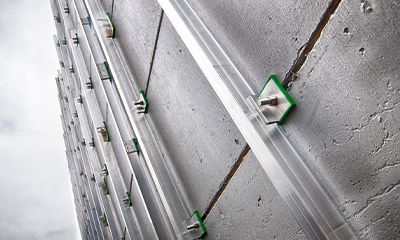Written by Hitesh Pattni (North) and Neil Kirwan (South) - Specification Managers in SFS Group Fastening Technology Ltd.
Earlier engagement in technical design with building product manufacturers can help to reduce the complexity of dealing with fire safety requirements in the construction industry.
Few areas of building and specification have seen as much scrutiny and change as fire safety. That will remain the case for the foreseeable future. Engaging in technical design with building product manufacturers at an earlier stage of projects can help to reduce the complexity of dealing with frequent change.
Rising insurance premiums and a culture of risk aversion, have gone hand in hand as the industry has sought to navigate the changed landscape.
Nobody believes more focus on fire performance and safety is a bad thing. However, there is a case for asking whether better awareness is leading to a better understanding of how products and systems behave, if and when the worst happens.
Construction product manufacturers are rightly expected to be transparent about their product testing, with clear communication of results. Even where that clear communication is in place, however, a suitable product or system might be rejected from a specification due to risk averse thinking.
Specifiers can find themselves looking for solutions that either the market can't provide, or which are an over-specification for the particular project, because expectations are not aligned with what is actually required, or available.
There are questions as to whether the testing regime generally, and for fire safety specifically, is going enough.
Different fire safety measures and requirements in the different countries of the UK only add to the complexity of the overall picture. In Scotland, for example, combustible materials have been banned from external wall constructions in buildings that exceed 11m in height, even where good test results have been demonstrated.
The regulations in England continue to use 18m as a threshold, with requirements applying to 'relevant buildings' but excluding 'specified attachments' that are part of the wall construction.
The direction of future regulations, and how they will align with the risk averse thinking of building insurers, is unclear.
BR135 sets out the performance criteria for cladding systems in terms of fire safety. Changing thermal performance requirements are increasing insulation thickness in the building envelope, and we are seeing building envelopes with insulation so thick that it cannot fixed and also meet the BR135 criteria.
Early engagement allows specifiers to work closely with manufacturers of building envelope systems. Through collaboration, it's possible to establish what is required and what solutions are available to meet those needs. Regulatory requirements can be met without over-specification.
The specifier can progress through the later design stages confident of having a robust specification and a compliant solution. Perhaps most-importantly, they won't have assumed any risk for its selection.
One of the biggest barriers to achieving robust specifications and closing performance gaps is cost engineering. Seeking to substitute products purely on cost grounds leads to more risk and greater uncertainty, as it doesn't take a 'whole building' view of the project.
No reassurances that an alternative product is “similar approved” can surmount the fact that, often, the proposed substitution has not been tested or certified as part of the original build-up. Rarely is it so simple, especially in a building envelope specification, that one product can simply be swapped out for another.
Early engagement results in better collaboration. As different parties gain a better appreciation for what each other needs, and how they can support each other, it becomes easier to aim for performance, and to close performance gaps between ‘as designed’ and ‘as built’.
Learn more about robust fire safety specification and early engagement with manufacturers in our Whitepaper.
You can learn more about robust, sustainable building envelope specifications, and the benefits of engaging with product manufacturers, in our series off technical papers in 'SFS Talks' here.
How can early engagement help to improve fire safety performance?
Earlier engagement in technical design with building product manufacturers can help to reduce the complexity of dealing with fire safety requirements in the construction industry.
Few areas of building and specification have seen as much scrutiny and change as fire safety. That will remain the case for the foreseeable future. Engaging in technical design with building product manufacturers at an earlier stage of projects can help to reduce the complexity of dealing with frequent change.
Rising insurance premiums and a culture of risk aversion, have gone hand in hand as the industry has sought to navigate the changed landscape.
Nobody believes more focus on fire performance and safety is a bad thing. However, there is a case for asking whether better awareness is leading to a better understanding of how products and systems behave, if and when the worst happens.
Do specification decisions reflect fire testing results?
Construction product manufacturers are rightly expected to be transparent about their product testing, with clear communication of results. Even where that clear communication is in place, however, a suitable product or system might be rejected from a specification due to risk averse thinking.
Specifiers can find themselves looking for solutions that either the market can't provide, or which are an over-specification for the particular project, because expectations are not aligned with what is actually required, or available.
There are questions as to whether the testing regime generally, and for fire safety specifically, is going enough.
- Do different parties associated with construction projects understand what is being tested, and why?
- Are the results communicated clearly - first from the test house to the manufacturer, and then from the manufacturer to their architectural and specification audience?
- Are national building regulations clear enough about what is required and why?
- Is there clarity about when to look for individual product performance, and when to look for system testing results?
- Is enough value placed on system testing in the first place, especially when installers seek to substitute individual components in a building envelope system?
Different fire safety measures and requirements in the different countries of the UK only add to the complexity of the overall picture. In Scotland, for example, combustible materials have been banned from external wall constructions in buildings that exceed 11m in height, even where good test results have been demonstrated.
The regulations in England continue to use 18m as a threshold, with requirements applying to 'relevant buildings' but excluding 'specified attachments' that are part of the wall construction.
How could fire safety requirements change in the future?
The direction of future regulations, and how they will align with the risk averse thinking of building insurers, is unclear.
- Could combustible materials be banned on buildings of any height?
- What does good practice look like now, and is it possible to anticipate - and maybe even plan for - what good practice looks like in the future?
- How will changing fire safety regulations impact on other performance criteria?
BR135 sets out the performance criteria for cladding systems in terms of fire safety. Changing thermal performance requirements are increasing insulation thickness in the building envelope, and we are seeing building envelopes with insulation so thick that it cannot fixed and also meet the BR135 criteria.
What does early engagement look like in fire safety?
Early engagement allows specifiers to work closely with manufacturers of building envelope systems. Through collaboration, it's possible to establish what is required and what solutions are available to meet those needs. Regulatory requirements can be met without over-specification.
The specifier can progress through the later design stages confident of having a robust specification and a compliant solution. Perhaps most-importantly, they won't have assumed any risk for its selection.
One of the biggest barriers to achieving robust specifications and closing performance gaps is cost engineering. Seeking to substitute products purely on cost grounds leads to more risk and greater uncertainty, as it doesn't take a 'whole building' view of the project.
No reassurances that an alternative product is “similar approved” can surmount the fact that, often, the proposed substitution has not been tested or certified as part of the original build-up. Rarely is it so simple, especially in a building envelope specification, that one product can simply be swapped out for another.
Early engagement results in better collaboration. As different parties gain a better appreciation for what each other needs, and how they can support each other, it becomes easier to aim for performance, and to close performance gaps between ‘as designed’ and ‘as built’.
Need more information?
Learn more about robust fire safety specification and early engagement with manufacturers in our Whitepaper.
You can learn more about robust, sustainable building envelope specifications, and the benefits of engaging with product manufacturers, in our series off technical papers in 'SFS Talks' here.

 English (Canada)
English (Canada)
 čeština (Česká republika)
čeština (Česká republika)
 magyar (Magyarország)
magyar (Magyarország)
 Deutsch (Deutschland)
Deutsch (Deutschland)
 eesti (Eesti)
eesti (Eesti)
 español (España)
español (España)
 português (Portugal)
português (Portugal)
 English
English
 suomi (Suomi)
suomi (Suomi)
 français (France)
français (France)
 italiano (Italia)
italiano (Italia)
 Nederlands (Nederland)
Nederlands (Nederland)
 norsk, bokmål (Norge)
norsk, bokmål (Norge)
 polski (Polska)
polski (Polska)
 svenska (Sverige)
svenska (Sverige)
 Türkçe (Türkiye)
Türkçe (Türkiye)




